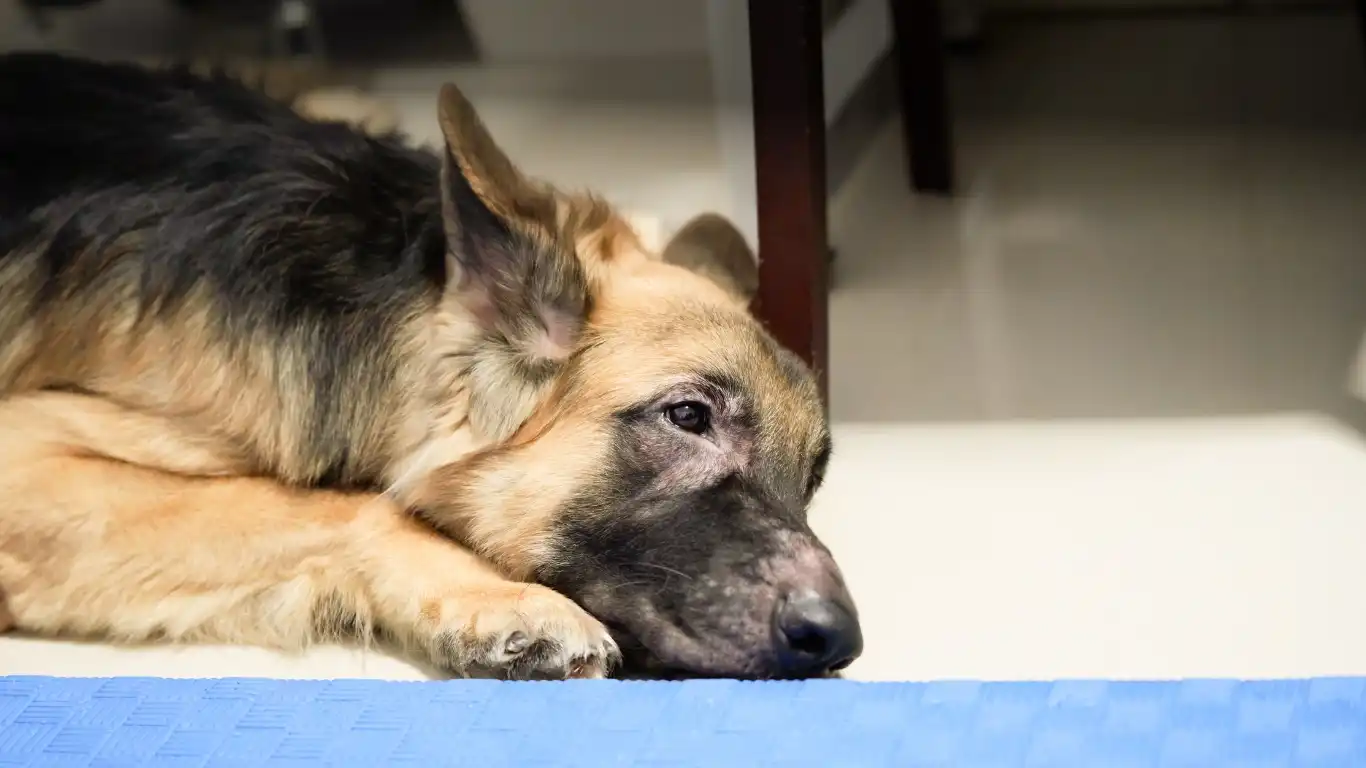Best Ways to Relieve a Dog’s Itchy Paws: Proven, Natural Remedies That Work
As a Pet Nutritionist and pet care expert with years of experience in veterinary clinics, I’ve seen my fair share of dogs suffering from itchy paws. It’s frustrating for both the dog and their owner. If you’ve ever noticed your pup constantly licking, chewing, or scratching at their paws, you know just how troubling it can be. It’s more than just a nuisance—it can indicate underlying health issues. But don’t worry! There are plenty of best ways to relieve a dog’s itchy paws, and I’m here to guide you through them. With a little attention and the right care, you can help your dog feel better and get back to enjoying their walks, playtime, and cuddles. So let’s dive in!
Why Are Your Dog’s Paws Itchy?

Before we jump into solutions, it’s important to understand why your dog’s paws are itchy in the first place. The causes can vary from environmental factors to more serious health concerns, so it’s essential to pinpoint the problem to provide the best care. Here are some of the most common reasons for itchy paws:
1. Allergies
Just like humans, dogs can have allergies. Whether it’s to pollen, certain foods, or household cleaning products, allergens are one of the leading causes of itchy paws. You may notice that your dog’s paws are most itchy after they’ve been outside or after they’ve eaten something new. In some cases, it could even be a reaction to something as simple as a change in the detergent you use on their bedding.
2. Dry, Cracked Skin
Dry weather, hot pavements, and even salty sidewalks can lead to cracked, dry paws. If you live in an area with extreme temperatures, your dog might struggle with dry skin, leading to discomfort and itching. The skin can become brittle, and your dog may lick or chew to alleviate the irritation, which often makes the problem worse.
3. Fungal or Bacterial Infections
Infections are another common culprit behind itchy paws. Fungal infections, like yeast, can cause significant discomfort, and bacterial infections can also create inflammation and redness. These infections often require treatment with special shampoos or medications from your vet.
4. Foreign Objects and Debris
Sometimes, all it takes is a small pebble or piece of dirt lodged between your dog’s paw pads to cause persistent itching. It’s not always obvious, but if your dog keeps licking one specific paw or area, it’s worth inspecting for any hidden debris or injuries.
5. Fleas or Ticks
Fleas and ticks are notorious for causing itchy skin. While most pet owners associate fleas with itching all over the body, it’s not uncommon for them to target the paws. If your dog is scratching excessively, especially in between their toes, fleas could be the issue. I’ve seen plenty of cases where fleas hide in the paw pads, making it tough for the dog to get relief until the problem is treated.
How to Relieve Your Dog’s Itchy Paws

Now that we know some of the causes, let’s explore the best ways to relieve a dog’s itchy paws. No matter the cause, there are several treatments and home remedies that can help soothe your dog’s discomfort. Here’s a list of my go-to methods:
1. Regularly Wash Their Paws
One of the easiest ways to help prevent and relieve itchy paws is by washing them regularly. I recommend using a gentle dog shampoo to wash off dirt, allergens, or salt that may be irritating your dog’s paws. After walks, rinse their paws with water and dry them off completely. In some cases, you might want to try a soothing paw soak with a mix of water and an oatmeal-based shampoo to calm any irritation.
2. Apply a Soothing Balm
If your dog’s paws are dry and cracked, a soothing balm can work wonders. Look for balms that contain natural ingredients like shea butter, coconut oil, or beeswax. These ingredients help lock in moisture and promote healing. I’ve personally used paw balms on many dogs, and they can make a noticeable difference in just a few applications!
3. Check for Foreign Objects
Always inspect your dog’s paws for any foreign objects, like small pebbles, twigs, or even burrs. These can easily get lodged between their toes or in the pads, causing discomfort. If you find something stuck, gently remove it with a pair of tweezers or consult your vet if it’s difficult to remove.
4. Anti-Itch Sprays or Creams
If your dog’s itching is due to allergies or dry skin, consider using an anti-itch spray or topical cream specifically designed for pets. Look for products with calming ingredients like aloe vera, chamomile, or hydrocortisone (for mild cases). I often recommend these for dogs who need quick relief from the constant urge to scratch.
5. Make Dietary Adjustments
Did you know that a dog’s diet can affect their skin health? If your dog is prone to allergies, food could be a major trigger. Consider switching to a hypoallergenic dog food or one that’s rich in omega-3 fatty acids. These can help improve skin health from the inside out, reducing inflammation and itching. This is a personal favorite of mine—I’ve seen many dogs benefit from a better diet when dealing with skin issues!
6. Visit the Vet
If your dog’s paws continue to itch despite trying home remedies, it’s time to consult your vet. In some cases, persistent itching can be a sign of a more serious condition like fungal or bacterial infections. A vet can perform tests to identify the root cause and provide the necessary treatment to get your dog back to their playful self.
In my years of working with dogs, I’ve learned that relief often requires a multi-faceted approach. It’s not always about just treating the symptoms—it’s about understanding the underlying issue and addressing it at the source. So whether it’s allergies, infections, or simple dryness, you have options to help your dog’s paws feel better.
Keep Your Dog’s Paws Healthy and Happy

Maintaining healthy paws goes beyond just relieving itching. Regular care and attention to your dog’s paws can help prevent issues from developing in the first place. Make sure to keep their paws clean, trimmed, and moisturized to avoid discomfort. The better you take care of their paws, the less likely you’ll run into these problems in the future. Trust me, it’s worth it for both you and your dog!
Prevention: The Key to Healthy, Itch-Free Paws

While treating itchy paws is important, preventing them from becoming an issue in the first place is even better. Preventive care can save you from dealing with more serious problems down the road. And trust me, as someone who’s worked with dogs for years, I can tell you that small changes in your dog’s routine can make a huge difference in the long run. Here’s how you can help keep your dog’s paws in tip-top shape:
1. Regular Paw Inspections
One of the easiest—and most overlooked—ways to prevent paw issues is to inspect your dog’s paws regularly. I recommend doing a quick check after every walk or outdoor playtime. Look for signs of dirt, debris, or injuries between the pads and around the nails. You’d be surprised how often small cuts or little pebbles go unnoticed but can lead to larger problems if left untreated. I’ve had many clients come to me with dogs that had chronic paw issues simply because they weren’t checking their dog’s paws regularly.
2. Keep Nails Trimmed
Long, overgrown nails can cause discomfort and even lead to injury. They can put additional pressure on the paw pads and cause irritation, which can result in itching or even infection. Trimming your dog’s nails regularly is an essential part of paw care. If you’re unsure how to trim them, ask your vet for guidance. I always recommend having a professional trim the nails if you’re not comfortable doing it yourself, as it’s easy to accidentally cut too far. Some dogs even get little “nail caps” as a preventative measure, which can help prevent further damage and irritation.
3. Protect Their Paws from Harsh Environments
Dogs love to explore, but sometimes their paws can suffer from harsh environments. Hot pavement in the summer, icy sidewalks in the winter, or even chemicals like antifreeze can all cause irritation. Whenever possible, avoid walking your dog on extreme surfaces. If it’s too hot or too cold outside, try walking during cooler hours or on grassy areas where the ground is gentler on their paws. There are also dog booties you can buy, which protect their paws from harsh weather or dangerous chemicals. They’re not the most fashionable accessory, but they’re a lifesaver if you live in an area with extreme weather.
4. Moisturize Their Paws
Dry, cracked paws can be a nightmare. I’ve worked with many clients whose dogs suffer from cracked paw pads, especially in the winter months. The good news is that moisturizing your dog’s paws is simple. You can use natural paw balms or oils to help keep their paws soft and hydrated. If you prefer a more DIY approach, coconut oil works wonders! It’s natural, safe for dogs (if ingested), and it provides deep moisture. I use it all the time on my own pets, especially during dry spells.
Natural Remedies for Itchy Paws

If your dog is dealing with occasional itching or mild discomfort, there are some great natural remedies you can try at home. These remedies are not only effective but are also gentle on your dog’s skin. Here are a few I’ve used with great success:
1. Oatmeal Soaks
Oatmeal is a fantastic natural ingredient for soothing irritated skin. I’ve recommended oatmeal soaks to many clients, and the results speak for themselves. You can create an oatmeal bath for your dog by grinding up plain, unsweetened oatmeal and adding it to warm water. Let your dog soak their paws in the water for a few minutes to help relieve itching and inflammation. It’s calming and helps to restore moisture to the skin, making it feel better almost immediately.
2. Aloe Vera
Aloe vera is known for its healing properties, and it’s safe to use on your dog’s paws as long as it’s pure and free from additives. It’s great for soothing irritated or inflamed skin. I’ve personally used aloe vera gel on several dogs that suffered from dry, cracked paws during the winter months. It helps cool down the skin and promotes healing. Just be sure to keep an eye on your dog to make sure they don’t lick it off too quickly, as it can cause mild stomach upset if ingested in large amounts.
3. Apple Cider Vinegar Soaks
Apple cider vinegar (ACV) is another wonderful natural remedy that can help with itchy paws. Its antibacterial and antifungal properties make it great for preventing infections that can cause further irritation. To use ACV, dilute it with water (about one part vinegar to three parts water) and soak your dog’s paws for 5-10 minutes. This can help to reduce itching caused by yeast or bacteria. I always recommend following up with a moisturizing treatment afterward, as ACV can dry out the skin if used too frequently.
4. Chamomile Tea Soaks
Chamomile isn’t just for humans—it works wonders for dogs too! The anti-inflammatory properties of chamomile help to calm down irritated skin and reduce itching. I love recommending chamomile tea soaks for dogs with mild itching or inflamed paws. Simply brew a strong cup of chamomile tea, let it cool, and soak your dog’s paws in the tea for 5-10 minutes. It’s a relaxing, soothing remedy that can provide immediate relief.
When to Seek Professional Help

While natural remedies and home care are often effective for mild cases of itchy paws, there are situations where it’s best to consult a vet. If your dog’s paw issues persist despite your efforts, or if you notice signs of infection, it’s time to get professional help. Some signs that you should seek veterinary care include:
- Excessive licking, chewing, or biting of the paws
- Redness, swelling, or sores that don’t improve with home treatment
- Foul odor or discharge coming from the paws
- Visible cuts, punctures, or injuries that haven’t healed
- Changes in your dog’s behavior, like limping or avoiding walking
Don’t hesitate to reach out to your vet if you’re concerned. Your vet can run tests to determine if there’s an underlying health issue, such as an infection, allergy, or even autoimmune disorder, that’s causing the problem. I always tell my clients that it’s better to catch these things early and get the proper treatment rather than waiting until the condition gets worse.
Helping your dog with itchy paws can be a bit of a puzzle, but with the right knowledge and care, you can help them find relief. Remember, the goal is not only to soothe the discomfort but also to prevent future issues from cropping up. With the right preventive measures, you can keep your dog’s paws healthy and itch-free!
Case Studies & Real-Life Examples

Let’s take a look at a few real-life examples of how different methods worked for dogs experiencing itchy paws. It’s one thing to talk about solutions in theory, but I’ve seen firsthand how they play out in practice. I’ve worked with so many pet owners in my years as a pet nutritionist and veterinary clinic expert, and these stories are a great way to illustrate how the right approach can make all the difference.
Case 1: Luna, The Allergy-Prone Lab
Luna, a sweet Labrador retriever, came to me with constant paw licking and chewing. Her owner noticed she’d been excessively licking her paws, especially after being outside for walks or hikes. After ruling out infections and parasites, we zeroed in on the fact that Luna was suffering from environmental allergies—she was allergic to certain types of pollen. Her paws were reacting to the allergens she was picking up from the grass and dirt.
After switching to a hypoallergenic food and starting Luna on a consistent paw cleaning routine (wiping her paws with a mild, dog-safe wipe after every outdoor activity), her symptoms significantly improved. Luna also benefited from weekly paw soaks using oatmeal-based products, which helped soothe her itchy, inflamed skin. Her owner even started using a natural paw balm after each soak, which kept her paws soft and free from cracks.
Case 2: Max, The Senior Dog with Dry Skin
Max, a senior German Shepherd, had been dealing with dry, cracked paws for quite some time. His owner didn’t realize the importance of moisturizing his paws regularly. Max had also been limping a bit, which made it more difficult to spot the early signs of paw irritation. By the time Max was brought in for a consultation, his paw pads were visibly dry and rough, and he was licking them incessantly.
We started by moisturizing his paws with coconut oil and applying an all-natural paw balm. Additionally, I recommended a diet rich in omega-3 fatty acids to help improve his skin health from within. After a few weeks of consistent care, Max’s paws looked so much healthier, and his limping significantly improved. The key here was not just treating the paws but also addressing the root cause—dryness—which required dietary changes and consistent moisturizing. Max’s owner was thrilled to see his dog moving around comfortably again!
Case 3: Daisy, The Puppy with Sensitive Paws
Daisy, a young Cocker Spaniel, had extremely sensitive paws that were prone to redness and irritation. After a thorough check-up, we discovered that her problem was mostly due to harsh cleaning products being used in the home. Daisy’s owner had recently switched to a new floor cleaner, which was irritating Daisy’s delicate paws.
We immediately switched to pet-safe, gentle cleaning products around the house, and Daisy’s owner started regularly wiping her paws after each walk. Additionally, I recommended a soothing chamomile tea soak and a natural, vet-approved paw cream. Within a week, Daisy’s paws were less red and inflamed, and she stopped chewing on them. This was a perfect example of how something as simple as changing household cleaning products can make a big difference in your pet’s health.
Key Takeaways: What You Need to Remember

Let’s recap the most important takeaways to help you relieve your dog’s itchy paws and maintain their overall paw health:
- Identify the Cause: Before starting treatment, try to identify the root cause of your dog’s paw issues. Whether it’s allergies, dry skin, infections, or something else, knowing the cause helps you select the most effective solution.
- Regular Paw Inspections: Check your dog’s paws frequently for signs of dirt, debris, or injury. Regular inspections help catch problems early.
- Prevention is Key: Keep your dog’s paws clean, moisturized, and protected from harsh elements. Regular trimming and using paw balms can prevent discomfort.
- Use Natural Remedies Wisely: Natural remedies like oatmeal soaks, aloe vera, and coconut oil can be great for soothing itchy paws, but always use them as part of a holistic care routine. If the condition persists, consult your vet.
- Consult a Vet: If your dog’s paw problems don’t improve with home care or if you notice signs of infection or severe irritation, don’t hesitate to seek professional advice.
FAQs
Here are some frequently asked questions I get from pet owners dealing with itchy paws:
1. Can I use human products on my dog’s paws?
While some human products (like coconut oil or aloe vera) are safe for dogs in moderation, it’s essential to avoid using products specifically designed for humans, especially those with added chemicals or fragrances. Stick to pet-safe products that are formulated for canine use.
2. How often should I clean my dog’s paws?
It’s a good idea to clean your dog’s paws after every walk or outdoor play session. This helps remove any allergens, dirt, or salt that could irritate their skin. If your dog has a tendency to lick their paws afterward, you can try a soothing wipe or a quick rinse with water to prevent irritation.
3. My dog keeps licking their paws even after I treat them. Should I be worried?
If your dog continues licking their paws despite treatment, it could be a sign that the issue is ongoing or that they’ve developed a habit. Persistent licking can lead to further irritation, so it’s best to consult your vet if home treatments don’t seem to help.
Bonus: Additional Resources or DIY Tips
If you’re interested in more ways to keep your dog’s paws healthy and itch-free, I’ve gathered a few additional resources and DIY tips:
- PawPatron: Your Go-To Resource for Dog Health
- How to Make Your Own Dog Paw Balm at Home
- Natural Remedies for Dog Skin Health
Appendix: Table, References, Disclaimer, and Call to Action
Disclaimer: The information in this article is intended for educational purposes only and should not replace professional veterinary advice. If you suspect that your dog’s itchy paws are related to a medical condition, please consult a veterinarian.
Call to Action: If you found these tips helpful, share this article with fellow dog owners! You can also sign up for our newsletter for more pet care advice, tips, and updates straight to your inbox. Together, we can keep our furry friends happy, healthy, and itch-free!





